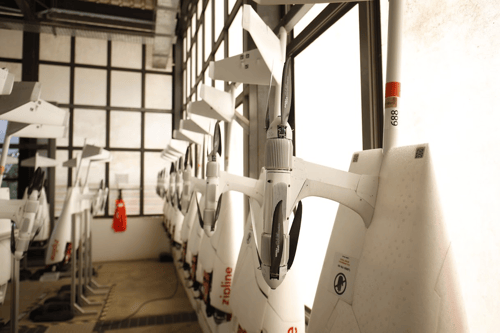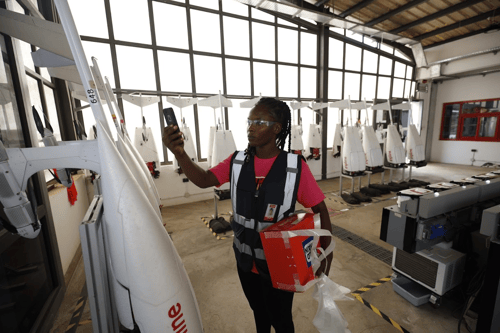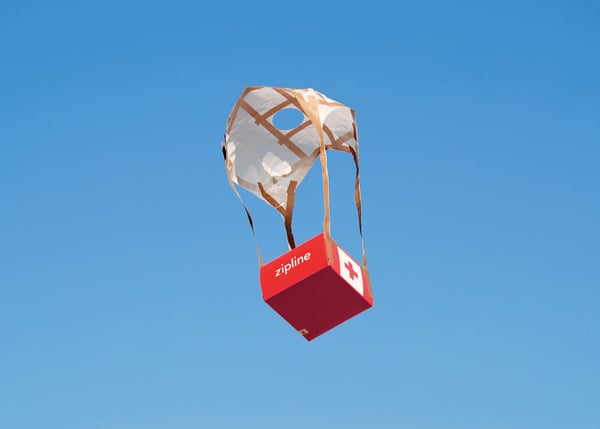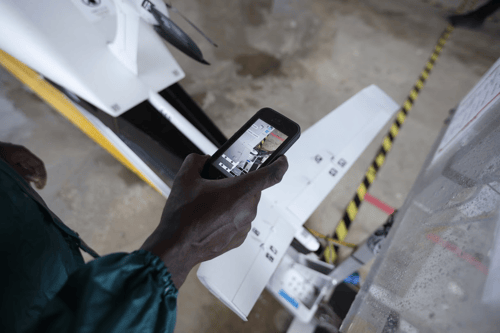 By Michael Oliver
By Michael Oliver
I have been working in the drone industry now for around 4 years, and I find the speed of technology development and ambition is second to none when it comes to Innovation. There are some businesses out there achieving truly amazing things with drone technology, and one of those businesses is Zipline.
Powering medical drone deliveries across several parts of Africa and now commercial deliveries within the USA, Zipline’s path to scalable drone delivery has been nothing short of remarkable.
I spoke to Dan Mehringer, SVP of New Markets at Zipline, to find out more about his view of the industry, potential opportunities, and challenges, and what drives him day-to-day.
Dan, thank you for taking the time to talk to me about the drone industry from your perspective. It would be great if you could introduce yourself and tell us a bit about your background and what motivates you to work in the drone delivery sector?
As Zipline's SVP of New Markets, I lead our go to market efforts across Europe, Asia, South America, and GCC. I'm relatively new to Zipline, having previously led Corporate Development and Strategic Partnerships for Harley-Davidson.
It was actually at Harley where I started to develop an appreciation of the pace of change of logistics and transport. As my understanding grew, I came to believe we are at a generational inflection point in terms of logistics capabilities and consumer expectations of those capabilities.
I knew that autonomous drones would have a substantial role to play in this new environment, but to be honest my sense was that the current state of the industry was better suited to PR stunts rather than reshaping logistics at an industrial scale. Zipline changed this perception materially for me and convinced me to enter the space.
Operationally, there is an order of magnitude difference between Zipline's experience and that of any other operator. This means we can partner with clients today and affect material change in their models and outcomes at scale.
All of this is why I'm here and why I’m tremendously excited about my chance to contribute to the Zipline journey. We will drive substantial efficiencies for our corporate and government partners while changing consumer perception of what is possible in personal logistics. Watch this space.
Although drone delivery has been under development for a while, it feels like the COVID Pandemic has led to a step-change in opportunities for drone-based delivery. Certainly for SOARIZON, we have been extremely busy with various projects and interesting new opportunities during 2020. I’ve commented before that, in this case, necessity really has been the driver of innovation - what is your perspective?
COVID has disrupted the global economy in every way - a simultaneous supply side shock and a demand side shock. It has changed how goods are manufactured and delivered, it has changed how and where work is done, and it has accelerated disruption in the consumer space - from retail to healthcare.
It has provided a tail wind to global ecommerce so strong that we’re looking at transportation shortages heading into the holiday season. In healthcare, COVID has accelerated an ongoing trend toward more decentralized care and exponentially increased the adoption of telemedicine. All of these factors contribute to a growing recognition that we need new ways to make our supply chains more resilient, more flexible, and better able to meet consumer demand.

We see interest from across a wide range of industries that autonomous delivery, by drone, will be a key piece of the logistics puzzle going forward. There are a lot of players nipping at the edges of the still nascent commercial drone industry, but nobody other than Zipline is delivering nationwide logistics at enterprise scale.
Zipline has moved light years beyond the phase of drone demonstration pilots for PR. We are focused on running programs that deliver critical products every moment of the day and drive real ROI at scale. We’re not concerned with being the “first” drone to deliver a burrito or a widget in a controlled test for headlines. As companies look for solutions in this space they are looking for firms who can deliver value today and have experience at scale.
One of the areas that the SOARIZON team have been focused on is enabling the true scaling of drone operations. It should no longer be about single flights, but services, and therefore scale. How do you see these drone services being delivered and do you see them complementing and providing efficiencies to existing logistics models or providing a completely new disruptive service?
There will always be a place in logistics for moving mass quantities of goods via ground or ship or airplane. What is novel and disruptive about our autonomous drone system is the speed and efficiency with which we can deliver goods directly to the end-user, short-circuiting so many of the areas of waste and friction common to logistics today. This is why Zipline is expanding as quickly as it is, and why I’m so excited for the traction we’re seeing in places like Israel, India and Europe, not to mention the US.

Think of the inefficiencies embedded in using a car or truck, for example, for last mile logistics. You have a 5,000 lb vehicle internal combustion vehicle, driven by a person, navigating city streets, looking for a parking spot, to deliver a single prescription, bag of groceries, sandwich, or last-minute gift. And on the other side of that delivery, you have a person waiting, often for hours, often taking time off work, to coordinate and receive a delivery.
Autonomous drones address every element of this, and as the technology and regulatory landscapes advance, drones will increasingly be the most efficient, convenient, and cost-effective solution for many types of goods.
Fulfilling the last mile promise to customers commands a disproportionate share of the delivery wallet for any firm shipping goods, from retail to healthcare - and we are confident that autonomous solutions will address the economics and bring the unit cost down significantly.
You have already mentioned the breadth of opportunities for drone delivery from retail to healthcare, and as our recent work in Scotland with the delivery of critical medical equipment to combat COVID-19 proves, this is getting close to reality. We have now seen the breadth of potential opportunities: What types of products or services do you see being some the best early adoption of this capability at scale?
For any on-demand, instant, delivery service, the sweet spot sits at the intersection of convenience and control, urgency and value - goods that need to be delivered within a specific time frame or delivered quickly after they are ordered, and which have relatively high inherent value, or value to the consumer.
Zipline’s founding program in Rwanda is of course the quintessential illustration of this intersection - there is perhaps no product more urgently needed, or of higher value, than blood during a medical emergency. In healthcare, there are many products, from vaccines to PPE, prescriptions, and medical supplies, that fit neatly into this space. That, combined with the moral imperative to build a delivery system that works equitably to deliver healthcare access for all people, is why Zipline has started with delivering vital medical supplies.

While our focus remains squarely on delivering medical products, and clients like Novant in the United States are aiming at home deliveries in 2021, we have also seen interest beyond healthcare. Walmart is partnering with Zipline to begin testing delivery of health and wellness products and we look forward to expanding that offering as the program scales.
At SOARIZON, we have seen incredible uplift in enterprise use of drones, particularly driven by drone inspection services at a national scale. How do you see the opportunities for drone delivery services from zipline, being truly scalable to a national level?
Zipline can help deliver products faster, more efficiently, and with a greater degree of control over and visibility into the customer delivery experience. We can also dramatically expand the range of existing instant delivery capabilities and in the process help change the way that industries warehouse and manage inventory for same-day and instant delivery.
There is no shortage of industries looking for better solutions, and we know that consumers are increasingly demanding instant delivery options. Our partnership with Walmart is just one example of the interest we’re seeing as retailers turn their attention to providing the best possible customer experience while positioning themselves to address the unit economics of instant delivery.
But what we’re really excited about is the power of this type of a service built out to national scale.
Zipline is committed to building an autonomous delivery system that is capable of reaching everyone, anywhere - that’s the DNA that underlies our entire engineering effort. What’s unique about long range, autonomous, on demand delivery is that it can help us reach someone in a small town in North Carolina, or rural village in Ghana, as easily and efficiently as someone in a major metropolitan area.
There are still undoubtedly some technical and regulatory challenges to address before this sector truly becomes business as normal. Within Thales, we are working on UTM services, connectivity solutions, digital platforms and electronic conspicuity to name but a few. Tell me what are some of the technology challenges are, what have you managed to overcome, and what are those still to be addressed?
 A list of technology challenges that we have overcome would be a list of our entire tech stack and operations - from the aircraft itself to the launching and recovery system. From the software that powers the world’s largest autonomous logistics network to the inventory management and ordering systems that we have custom built. Pretty much everything we’ve built people told us would be impossible to build.
A list of technology challenges that we have overcome would be a list of our entire tech stack and operations - from the aircraft itself to the launching and recovery system. From the software that powers the world’s largest autonomous logistics network to the inventory management and ordering systems that we have custom built. Pretty much everything we’ve built people told us would be impossible to build.
And all of these systems are already operating at national scale, every day, delivering life-saving medicines and supplies to over 23 million people served by over 2,500 medical facilities served by Zipline. Today, around the world, someone receives a Zipline delivery every four minutes and, as of December 2020, we have completed over 80,000 commercial deliveries. This scale still amazes us, and it puts us light years ahead in terms of our experience and the completeness of our service.
Presently, the technology challenges we, and all drone manufacturers and operators, face are as much about getting our technology accepted by civil aviation authorities as they are about new platforms or capabilities, although we certainly haven’t slowed down our engineering teams to wait for the regulators.
As much as the aircraft gets all the credit, it's worth noting here that a drone service is only as capable as the regulatory team that sits behind it, and at Zipline we’ve assembled the best and biggest team helping to open up markets for us around the globe.
We look forward to expanding commercial operations across the United States and the world in the coming months, and from there we will be steadily and quickly working our way toward the ability to deliver directly to millions of homes.
Thanks very much for your time and discussion, this has been really fascinating and I look forward to watching the expansion of drone delivery services over the coming years.